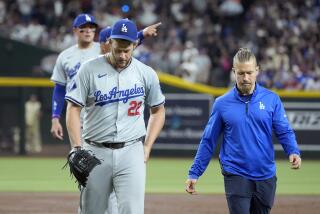Dodgers’ Kershaw, Billingsley can be classy at the bat
- Share via
It’s a question Clayton Kershaw can’t answer off the top of his head: What size bat does he use?
So the Dodgers’ star pitcher reached above his locker, pulled out one of his black bats, and scanned the bottom of the handle. “Thirty-four inches, 311/2 ounces,” he declared.
No surprise that Kershaw has to check — pitching is his priority, obviously — but one pleasant surprise for the Dodgers in their dreary season is that Kershaw and fellow starter Chad Billingsley have been among the better-hitting pitchers in the National League.
Their ability to do more with the bat than merely lay down sacrifice bunts not only has helped their cause as pitchers, it’s fueled a friendly feud between the teammates. Kershaw is able to claim he has more hits — 13 to Billingsley’s eight — while Billingsley can counter that he has one home run and three doubles.
Kershaw “has no extra-base hits whatsoever, all singles,” said Billingsley, whose locker is next to Kershaw’s.
“I know,” Kershaw acknowledged meekly.
Most pitchers are considered automatic outs at the plate. Starting pitchers play only every four or five days, relievers often give way to pinch-hitters, and all of them concentrate more on their main job of getting other batters out than safely reaching base themselves.
Pitchers’ lack of hitting prowess naturally is even more pronounced in the American League, which uses the designated hitter instead of having pitchers come to bat.
But in the National League, several pitchers are known for being dangerous hitters, and Kershaw and Billingsley are among them.
“You take it very seriously, because there are a couple games throughout the course of the season where you can win a game as far as getting a bunt down or the big hit,” Billingsley said. “It’s happened quite a few times.”
Just ask another of the Dodgers’ starters, Ted Lilly. In Tuesday’s game against Philadelphia, Lilly had a 2-0 count on rival pitcher Cliff Lee and, Lilly acknowledged later, “[I] was thinking [Lee] might take” the next pitch in hopes of drawing a walk.
Instead, Lee belted the ball into the right-field pavilion at Dodger Stadium and it proved the difference as the Phillies won, 2-1. It was Lee’s second home run of the season, and the former Cy Young Award winner is batting .226 (12 for 53).
“Any time I do something with the bat ... it leads to positive things for the team,” Lee said after the game. “Any time it’s a one-run game and you can extend the lead, it’s huge.”
Or consider the Dodgers’ game against the Phillies on Wednesday, when Billingsley blew an early 6-0 lead partly by giving up a run-scoring single to Philadelphia rookie pitcher Vance Worley. That run mattered too, as Philadelphia won again, 9-8.
Among NL pitchers with at least 35 at-bats entering Thursday’s games, Carlos Zambrano of the Chicago Cubs — long known as a good-hitting pitcher — was tops in batting average at .333 (14 for 42) and had two home runs. Daniel Hudson of the Arizona Diamondbacks is batting .319 (15 for 47) with one home run.
Next was the 23-year-old Kershaw, whose 13 hits in 52 at-bats give the left-hander a batting average of .250 and are more hits than the 10 he had in his previous three seasons combined.
Asked to explain the surge this season, Kershaw said, “I don’t know why. Maybe just better swings.”
Regardless, “I’m definitely getting more breaking balls” from other pitchers, Kershaw said.
Does he take that as a compliment? “I guess it’s showing [me] a little respect, yeah,” he replied. “I don’t ever expect to get a breaking ball from a pitcher, so I definitely need to start thinking about it more.”
Billingsley, who is mired in an 0-for-15 slump, thinks about it a lot. “There have been several times where I see — out of three at-bats [in a game] — maybe only three fastballs,” with the rest being “cutters, sliders, things like that,” he said.
That Kershaw and Billingsley are among the relatively few good-hitting pitchers doesn’t surprise former Dodgers manager Tom Lasorda.
“A lot of pitchers don’t prepare themselves to hit, they just pitch,” Lasorda said. “They don’t take a lot of batting practice.”
Kershaw and Billingsley take batting practice before every home game at night, but seldom on the road because there isn’t as much time for pregame batting practice for the visiting club.
Their friendly rivalry about hitting gained steam in 2009 when Randy Wolf, now with the Milwaukee Brewers, was a member of the Dodgers’ starting rotation.
“Wolf loved to hit, and he started this little pitchers’ hitting game” that awarded points based on “getting bunts down, getting the runner over, driving in runs, hits, stuff like that,” Billingsley said. “It was to teach us not to take our bats for granted.”
Conversely, Kershaw and Billingsley said they also have to bear down when pitching to the likes of Zambrano, Lee, Mike Leake of the Cincinnati Reds (batting .244), Yovani Gallardo of the Brewers (.231) and other good-hitting pitchers.
“Some guys you just pump fastballs down the middle. They have no shot, you know who they are,” Billingsley said without naming names. Overall, “If you make a quality pitch to a pitcher, throw the ball down in the [strike] zone, he’s not going to do too much with it.”
But as Lilly found out against Lee, there are exceptions.
As Kershaw put it, “There are definitely some [pitchers] where ... you throw whatever you got to get them out.”
More to Read
Go beyond the scoreboard
Get the latest on L.A.'s teams in the daily Sports Report newsletter.
You may occasionally receive promotional content from the Los Angeles Times.










